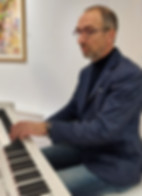ABOUT
Wim van de Wege is an artist who moves effortlessly between music, visual art, and the deep experience of nature.
After earning his conservatory diploma, he expanded his artistic journey at the Willem de Kooning Academy in Rotterdam. There, he immersed himself in modern art, contemporary visual language, and the role of the artist within society. The academy introduced him to progressive, conceptual approaches where traditional values were challenged and art became a visual manifesto of intuition, emotion, and critical reflection.
Yet, throughout his studies, nature remained a powerful counterbalance. While theory and concept shaped his understanding of contemporary art, Wim found his creative freedom outdoors — in the landscape. Plein air painting became an essential part of his practice. Outside, he experiences a profound sense of connection with the moment, the elements, and his inner world. His landscapes are not literal depictions but atmospheric impressions shaped by emotion, mood, and observation. The dramatic skies that often dominate his work serve as a stage for the ever-changing dance of light, air, and movement.


A boundary-crossing body of work
He works across various media, including oil painting, drawing, and mixed techniques. His style ranges from figurative to abstract, and he embraces experimentation as a way to push his artistic boundaries. Each artwork is a balance between form and freedom, structure and spontaneity — reflecting an inner journey and a search for meaning and wonder.
His work resonates with audiences both in the Netherlands and abroad. Wim’s paintings are part of private collections in countries such as Australia, United Kingdom, Germany, Belgium, France, Spain, Denmark, Norway, Sweden, and the United States. Through international exhibitions, online platforms, and art fairs, he has steadily built a reputation as an artist who creates honest, quiet, and deeply atmospheric pieces that connect with the viewer.
Inspiration and philosophy
Wim draws inspiration from the vastness of nature — the murmur of waves, the mystery of forests, the reflection of clouds on still water. But also from philosophy, literature, and music, which offer a continuous flow of ideas and reflections in his creative process. To him, art is not about providing answers, but about asking the right questions. It is a space for contemplation and new perspectives.
For me, art is a form of freedom — a space where rational thought gives way to intuition, experience, and emotion. I don't create to explain, but to invite: not just to look, but to truly see; not just to think, but to feel. Through my work, I aim to build a bridge between people and nature, between the everyday and the infinite. It’s a reminder of how small we are in the vastness of existence — and at the same time, how powerful our sense of wonder can be.
With each painting, I try to evoke a sense of stillness, reflection, and connection. I hope to create a space where imagination can wander freely, and where viewers are invited on a poetic journey between what is seen and what lies beyond.
Take a look in my studio and gallery
Wim
